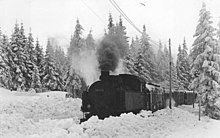NWE No. 51 and 52
| NWE No. 51–52 DR series 99.601 |
|
|---|---|
|
NWE 51 or 52 with a Walpurgis train (1932)
|
|
| Numbering: | NWE 51-52 99 6011-6012 |
| Number: | 2 |
| Manufacturer: | Borsig |
| Year of construction (s): | 1922, 1924 |
| Retirement: | 1964, 1966 |
| Axis formula : | (1'B) 'B1' h4vt |
| Genre : | K 46.10 |
| Gauge : | 1000 mm ( meter gauge ) |
| Length over buffers: | 10,350 mm |
| Height: | 3800 mm |
| Width: | 2700 mm |
| Fixed wheelbase: | 1300 mm |
| Total wheelbase: | 7800 mm |
| Empty mass: | 43.5 t |
| Service mass: | 53 t |
| Friction mass: | 39 t |
| Top speed: | 30 km / h |
| Indexed performance : | 480 kW |
| Driving wheel diameter: | 850 mm |
| Impeller diameter front: | 600 mm |
| Rear wheel diameter: | 600 mm |
| Control type : | Heusinger |
| Number of cylinders: | 4th |
| HD cylinder diameter: | 360 mm |
| LP cylinder diameter: | 560 mm |
| Piston stroke: | 400 mm |
| Boiler overpressure: | 14 bar |
| Grate area: | 1.99 m² |
| Superheater area : | 22.00 m² |
| Evaporation heating surface: | 85.89 m² |
| Water supply: | 6.0 m³ |
| Fuel supply: | 2.5 t |
| Locomotive brake: | Riggenbach counter pressure brake |
| Train brake: | Hardy suction air brake |
| Coupling type: | Balance lever coupling |
Locomotives No. 51 and 52 were two Mallet locomotives produced by the Borsig company in 1922 and 1924 for the Nordhausen-Wernigeroder Eisenbahn-Gesellschaft (NWE).
history
For the increased traffic, especially on the route to the Brocken, the NWE needed powerful locomotives. So the order for these two locomotives was made. They were strong, but also quite heavy with a service load of 53 tons. This resulted in unfavorable driving characteristics, and the locomotives were also quite prone to failure, so that they were not very popular. Both locomotives were taken over by the Deutsche Reichsbahn on April 1, 1949 with the numbers 99 6011 and 6012 and were in service until 1956. 99 6011 came to Gera in 1959 , where it was only in use in 1960. It was retired in 1966. In 1964 the same thing happened to the sister locomotive.
technical features
The two locomotives were superheated steam composite locomotives of the Mallet type. They had two two-axle driving frames, in which the second axle was driven, as well as a leading and trailing axle. The drive took place via a Heusinger control . In addition to the usual Hardy suction air brake , they also had a Riggenbach counter pressure brake . In the case of 99 6011, these brakes were removed for use in Gera and a Knorr compressed air brake commonly used there was installed. The supplies were carried on the locomotive. The small drive wheels in connection with the short wheelbase made for a restless run, and the locomotives tended to derail.
literature
- Horst J. Obermayer: Paperback German narrow-gauge steam locomotives . Franckh, Stuttgart 1971, ISBN 3-440-03818-1
- Hans Röper, Helmut Becker, Werner Dill, Gerhard Zieglgänsberger: The Harzquer and Brocken Railway. 3rd, extended edition, Transpress Verlagsgesellschaft, Berlin 1992 ISBN 3-344-70747-7
- Dietmar Franz, Reiner Heinrich, Reinhard Taege: The narrow-gauge railway Gera-Pforten – Wuitz-Mumsdorf . transpress, Berlin 1987, ISBN 3-344-00124-8

